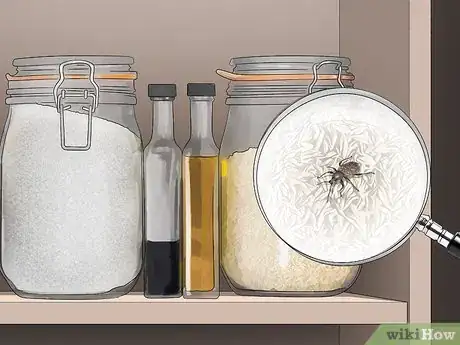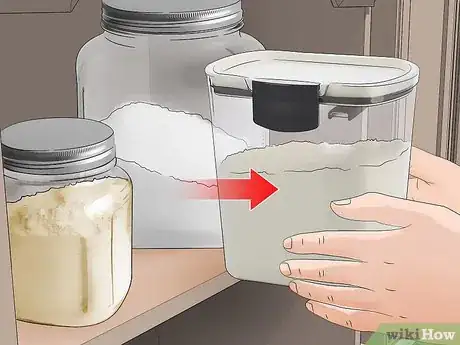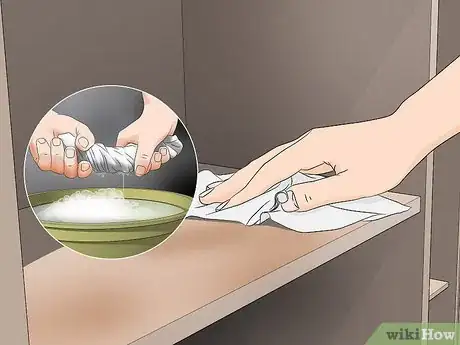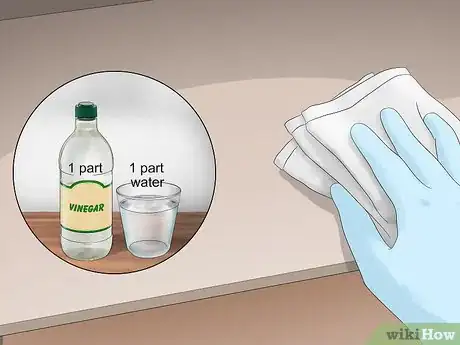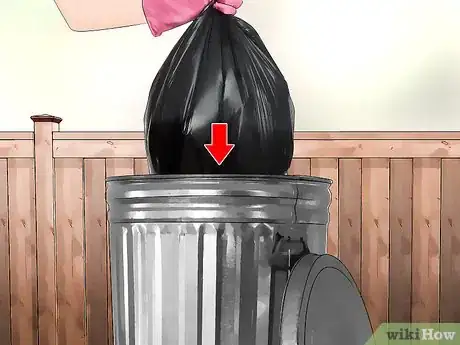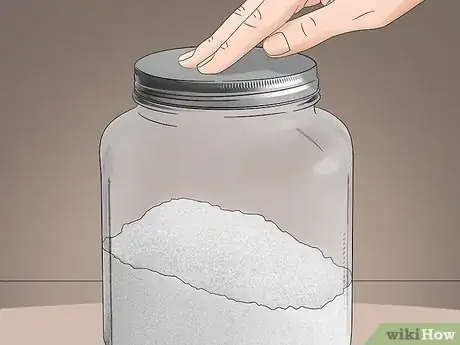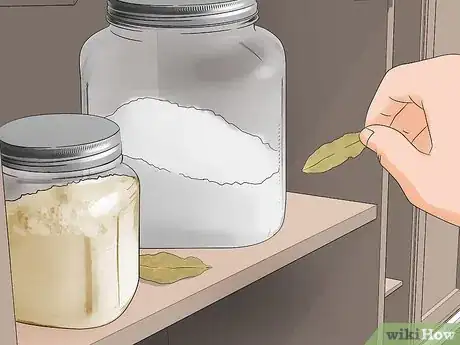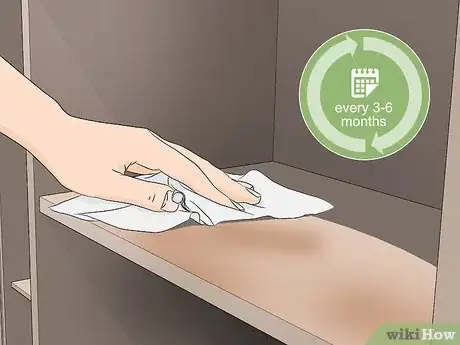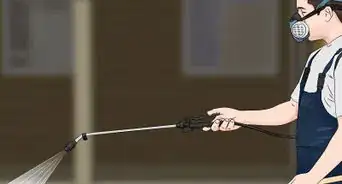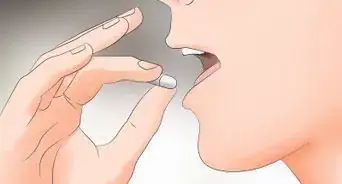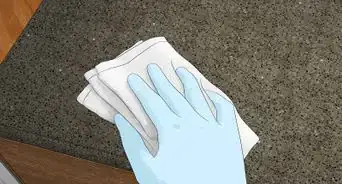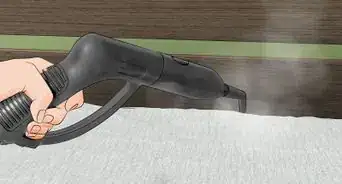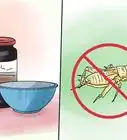This article was co-authored by Scott McCombe. Scott McCombe is the CEO of Summit Environmental Solutions (SES), a family-owned local pest solutions, animal control, and home insulation company based in Northern Virginia. Founded in 1991, SES has an A+ rating with the Better Business Bureau and has been awarded “Top Rated Professional,” and “Elite Service Award" by HomeAdvisor.
wikiHow marks an article as reader-approved once it receives enough positive feedback. In this case, 92% of readers who voted found the article helpful, earning it our reader-approved status.
This article has been viewed 276,000 times.
There are several varieties of pantry bugs, or pantry pests as they are commonly known, that like to infest foods normally stored in pantries and kitchen cupboards such as flour, grains, spices, and sugar or candy. Typical pantry pests include several varieties of grain beetles, flour weevils, and Indian meal moths. If you discover an infestation of pantry bugs, it’s important to fully clear the infestation, and take preventative measures to keep it from happening again.
Steps
Clearing the Infestation
-
1Inspect all of the food packages stored in your pantry and cupboards for bugs. Grain beetles and weevils are tiny black or brown bugs. Indian meal moths are gray with brown or bronze wings. Also, look for silk webbing left behind by moth larvae.[1]
- Pay special attention to packages of flour, rice, and other grain-derived products.
- Remember that the pests might not always be visible right away, so stir around the contents of packages or empty them out onto a baking sheet to check.[2]
- Don’t assume that because a package is well-sealed it doesn’t have bugs. Many types of pantry pests can squeeze through very small spaces to get at your food.
-
2Throw away any infested food and open packages.[3] If you find infested foodstuffs in your pantry, it’s best to throw away all other open packages that were in your pantry as well. Even if you don’t see bugs, it is highly likely that they have been laying eggs in other open packages.[4]
- If you really don’t want to throw away all of your open packages of pantry goods, you can freeze the ones that you didn’t see bugs in for 3-4 days to kill larvae.[5]
Advertisement -
3Remove everything from your pantry and vacuum the shelves. Get into all the shelves, corners, and crevices of your pantry with the hose of a vacuum cleaner. This will suck up any remaining bugs or cocoons, as well as spilled crumbs or grains.
-
4Wash the shelves with warm soapy water and a clean cloth or sponge. Do this to clean up any remaining crumbs, dust, and bugs or cocoons that the vacuum missed. Get into any corners or cracks as best as you can.[6]
- Wash any food storage containers with soap and water before returning them to the pantry.
-
5Wipe down all the shelves with a 50-50 water and white vinegar solution. Vinegar acts as a repellent to deter pantry bugs from coming back. It will also kill any bugs that may still be hiding in your cupboards![7]
- Do not use pesticides, bleach, or ammonia to wipe down the pantry. These chemicals will prevent infestations but can be dangerous if they touch any of your food.[8]
-
6Remove the trash from the house immediately. Tie up any bags of trash where you threw out contaminated food items and take them out of the house. If you leave them in the kitchen there is a high chance that the bugs will re-infest your pantry.[9]
- Wash out your kitchen trash can as well with soap and water.
- Take trash out of your kitchen frequently to lower the likelihood of attracting pests.
- If you dumped any infested food into your garbage disposal, run the garbage disposal under hot water for 1 minute.[10]
Preventing Future Infestations
-
1Wipe up any spills or crumbs from countertops, shelves, and floors right away. Always keep your kitchen and pantry as clean as possible. The longer spills or crumbs stay out, the more likely pantry pests are to come looking for a snack.[11]
- Use soap and water or a disinfecting countertop spray with a clean cloth or sponge to clean up messes.
-
2Purchase packaged foods that show no signs of damage. Examine packages of dried goods in the store for signs of a broken seal before taking them home. Even a small hole or tear means that pantry pests could already have infested the package.[12]
- Try to buy amounts of flour, rice, and other grains that you can use up in 2-4 months. The longer something sits in your pantry the more likely it is to get infested.[13]
-
3Store food in your pantry in airtight glass, plastic, or metal storage containers.[14] Purchase some good-quality storage containers with strong seals to keep your grains and other pantry goods in. Remember that pantry pests can squeeze through very small spaces, so an airtight seal is your best ally.
- Mason jars are a great airtight option for storing grains and other food, and also look great for organizing your pantry!
- If you can store anything from your pantry in the fridge, put it in there to keep it away from bugs.
-
4Put bay leaves in your pantry and in food packages to repel moths. Sprinkle bay leaves on the shelves of your pantry, or keep some in an open container on a shelf. Put 1 or 2 in open packages or containers of rice, flour, and other grains.[15]
-
5Clean your pantry regularly every 3-6 months. Even if you don’t have an infestation, take everything out of your pantry and throw away any old food items that could attract pests. Wash the shelves with warm water and soap, then wipe them down with a 50-50 water and vinegar solution.[16]
- If you have a recurring problem with pantry pests, call in a professional pest control expert to help you resolve and prevent the problem.
- Try putting pheromone traps or insect growth regulators (IGRs) in your pantry to help limit future pest problems.[17]
References
- ↑ https://www.foodnetwork.com/recipes/packages/kitchen-fixes/everything-about-pantry-pests
- ↑ https://www.foodnetwork.com/recipes/packages/kitchen-fixes/everything-about-pantry-pests
- ↑ Scott McCombe. Pest Control Specialist. Expert Interview. 19 November 2019.
- ↑ https://housewifehowtos.com/clean/get-rid-of-pantry-moths/
- ↑ https://www.foodnetwork.com/recipes/packages/kitchen-fixes/everything-about-pantry-pests
- ↑ https://housewifehowtos.com/clean/get-rid-of-pantry-moths/
- ↑ https://housewifehowtos.com/clean/get-rid-of-pantry-moths/
- ↑ https://www.foodnetwork.com/recipes/packages/kitchen-fixes/everything-about-pantry-pests
- ↑ https://housewifehowtos.com/clean/get-rid-of-pantry-moths/
- ↑ https://housewifehowtos.com/clean/get-rid-of-pantry-moths/
- ↑ https://www.pestworld.org/news-hub/pest-articles/keeping-kitchens-pest-free/
- ↑ https://www.pestworld.org/news-hub/pest-articles/keeping-kitchens-pest-free/
- ↑ https://www.foodnetwork.com/recipes/packages/kitchen-fixes/everything-about-pantry-pests
- ↑ Scott McCombe. Pest Control Specialist. Expert Interview. 19 November 2019.
- ↑ https://housewifehowtos.com/clean/get-rid-of-pantry-moths/
- ↑ https://www.thekitchn.com/the-best-defense-for-keeping-bugs-and-rodents-out-of-your-pantry-244767
- ↑ Scott McCombe. Pest Control Specialist. Expert Interview. 19 November 2019.
About This Article
To get rid of pantry bugs, start by inspecting all of the food packages in your pantry for tiny black or brown bugs. Pay special attention to any flour, rice, and grain packages, which pantry bugs like to eat. If you find any infested food packages, throw away all open foods in your pantry, in case the bugs have laid eggs in them. Once you’ve gotten rid of any open or infested packages, remove everything from your pantry and vacuum the shelves to clean up any remaining bugs or cocoons. After you’ve vacuumed, wash the shelves with warm soapy water or equal parts water and white vinegar to get rid of any bacteria. As soon as you’ve finished cleaning, take your trash out to prevent the bugs you caught from re-infesting your pantry. For more tips, including how to prevent future infestations of pantry bugs, read on!
